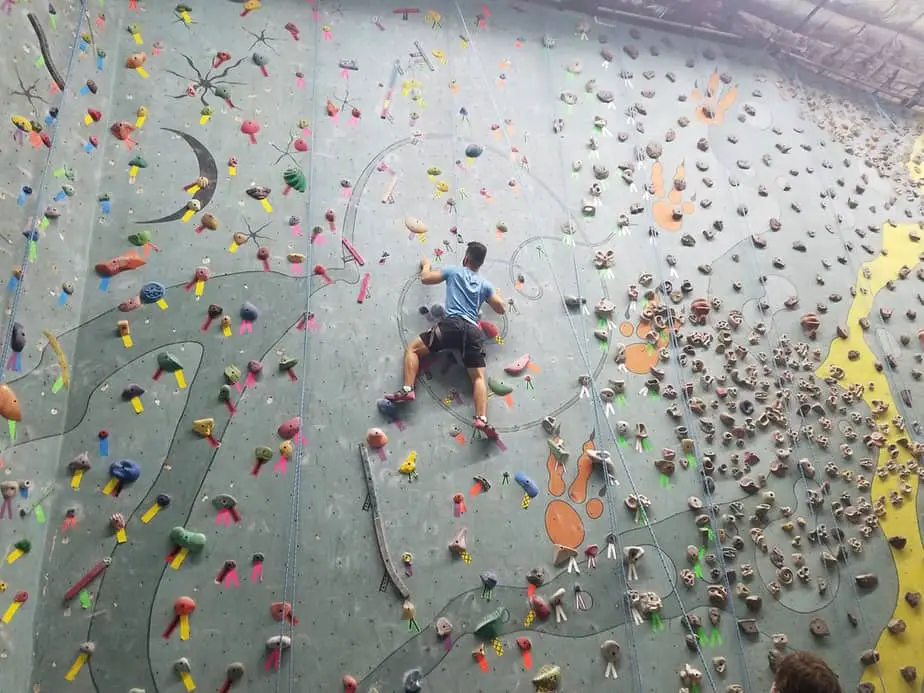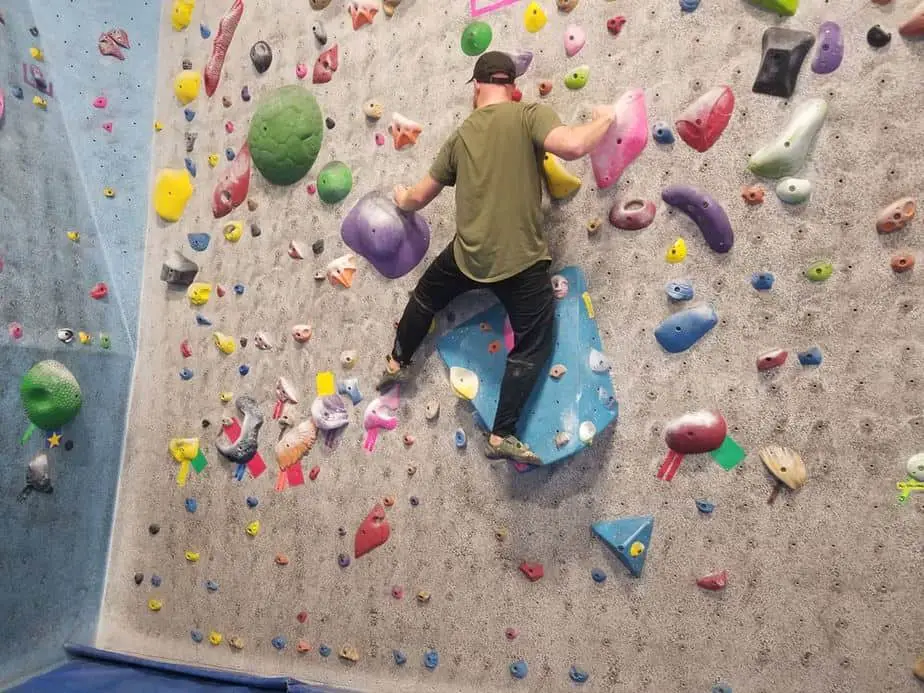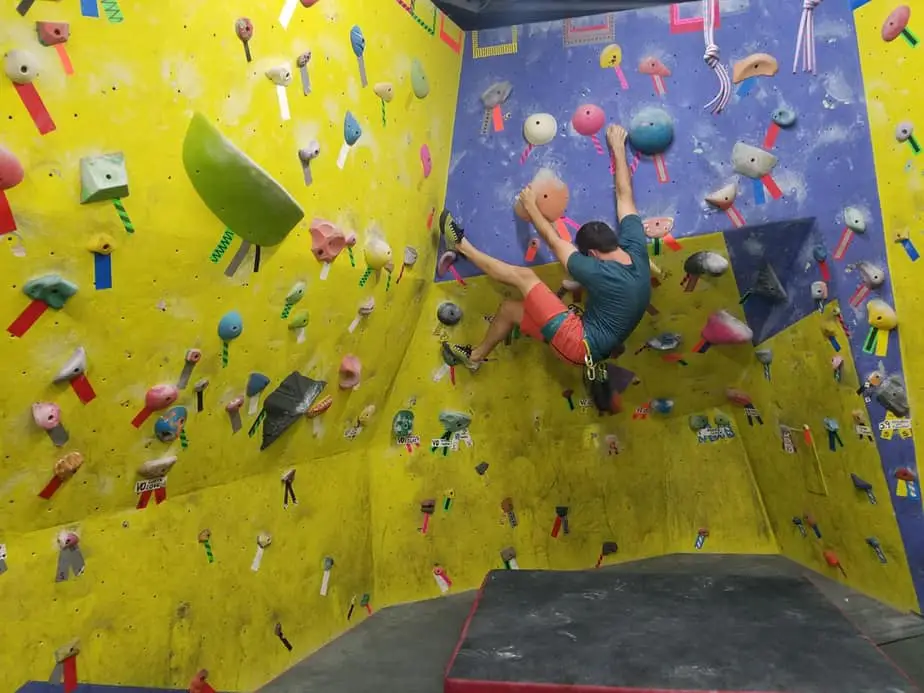Bouldering and top roping are the two most accessible forms of climbing to try as a beginner, and are the most common ways to climb at indoor gyms. However, other than those similarities, bouldering and top roping are very different.
Bouldering is harder than top roping because bouldering grades start at a much harder levels than top rope grades. It is also harder because you cannot rest on the rope and you fall farther if you slip or drop. Bouldering requires more strength while top roping requires more endurance.
Bouldering routes can vary significantly in length, safety, equipment, and the techniques required to ascend, in comparison to top rope routes. While many of the qualities of bouldering make it feel more accessible to beginners, most seasoned climbers feel like bouldering is more difficult.
What Makes Bouldering More Difficult than Top Rope Climbing?
- Equivalency of Climbing to Bouldering Grades
- Special Techniques Common to Bouldering
- Bouldering Requires Sustained Movements With No Rest
- Falling Farther Distances and Landing Hard
While bouldering routes are significantly shorter than roped routes, they often feel more difficult than top rope routes. This is because the easiest bouldering grades are equivalent to a more intermediate top roping grade (see grade comparison below).
Additionally, bouldering often requires techniques that require more practice than what’s needed for easy top roping, and thus they feel more difficult to a beginner. Bouldering can also be more difficult on your skin and hands.
With top rope climbing you’ll often hear the climber yelling “Take!” just before or after a difficult move. Climbers can rest whenever they need to by just leaning back against the rope.
A fall means starting at virtually the same area. A very nice belayer can, in essence, pull a climber up the wall an inch at a time.
With bouldering, however, you don’t get a break. If you fall, you start from the bottom every time. Problems are shorter than climbing routes, but have to be done in one attempt.
Finally, there is a different mental challenge to bouldering because a fall results in landing on the ground, whereas top roping prevents falls altogether. The main challenge with top rope climbing is just to learn to trust the rope and gear. Once you do that, the height doesn’t bother you.

How Do Grades Compare?
Different countries and regions use different climbing and bouldering scales to compare grades. The most common in the US are the Hueco or “V” Scale for bouldering and Yosemite Decimal System (YDS) for climbing.
Bouldering routes are graded on the “V” scale, which consists of grades from V0 – V17, with V0 being the easiest. Top rope routes are graded on the “YDS” scale, which consists of grades from 5.0 – 5.15d, with 5.0 being the easiest. However, while you might assume that a “V0” is equivalent to a “5.0”, it’s actually much closer to a “5.9”!
To try and make bouldering more accessible, many climbing gyms have added a bouldering grade to the beginning of the scale called “VB” or “V-Beginner”. This grade means that the bouldering route is easier than what fits on the standard scale.
Check out the table below for an approximate comparison of the V scale and YDS scale.
| V Scale | YDS Scale | Difficulty |
| VB | 5.0 – 5.9 | Easy |
| V0 | 5.10 (a,b,c,d) | Intermediate |
| V1 – V3 | 5.11 (a,b,c,d) | Intermediate |
| V4 – V6 | 5.12 (a,b,c,d) | Hard |
| V7 – V10 | 5.13 (a,b,c,d) | Hard |
| V11 – V14 | 5.14 (a,b,c,d) | Expert |
| V15 – V17 | 5.15 (a,b,c,d) | Professional |
Bouldering routes start at an intermediate climbing level and go up from there, which is a major reason that bouldering seems harder than top roping.
Of course, because top roping and bouldering are different in so many aspects, any comparison between their grading systems is imperfect. That being said, it’s easy to see why bouldering is harder than top roping when V0 is considered an intermediate difficulty!
To learn more about the details of the two different rating systems, check out our article Is Rock Climbing Hard For Beginners?.

Bouldering vs Top Roping Techniques
Now that you understand how the grading systems differ, you might be wondering if there are characteristics of bouldering that are inherently more difficult than top roping? At least in the gym, a very big difference between bouldering routes and top rope routes are the techniques required to ascend the route.
Because of the many differences between bouldering and top roping, the best way to make bouldering easier is to keep practicing bouldering routes, and be careful to avoid injury.
Power – Because boulder problems are so much shorter than top rope walls, setters at the gym tend to set fewer holds and space them farther apart so that there is only one likely path to the top. The consequence of this is that bouldering routes tend to require more power in comparison to top rope routes.
Strength – Top roping tends to occur on vertical walls that don’t deviate too significantly or for too long in angle from 90 degrees. Bouldering walls however can sometimes be dramatically overhung for the entirety of a route, which means that bouldering can require more upper body strength to be successful than easier top rope climbs.
Precision – When you are on top rope, you can stop at any point and try a move multiple times, but because bouldering does not use a rope, a climber can’t practice each move in isolation. Thus, bouldering requires more precision in comparison to top rope climbing.
Falling – You can’t really get hurt while climbing- it’s the falling that causes pain! It’s important to learn to fall correctly without twisting an ankle or breaking a wrist. Falling on top rope does take a little bit of practice, but is not near as perilous as falling while boudering.
Strength, power, and precision of movement are climbing skills that come with practice, and thus contribute to why bouldering is harder for beginners. Continuing to boulder is the best way to get better in all three areas!

Skin and Muscle Pain
The strength, power, and precision that bouldering requires means that you will probably start feeling pain in your arms, hands, and skin right away when you start bouldering.
Overhanging routes in particular are going to be hard on these parts of your body – while holds on a steep part of the wall might be bigger than on a flat section, more of your skin will be used and you’ll be more prone to “flappers”, or ripped blisters. You also can’t use your feet as much in an overhang, so your shoulders, arms, and hands will be taking most of the weight.
On more vertical sections of wall, the holds will likely be smaller or slopier, which means more force will be applied to your hands and wrists. These characteristics, combined with the precise nature of bouldering as well as the fall potential, means it’s easy to do a move and accidentally hurt yourself by over-gripping on a bad hold because you didn’t want to fall.
Mental Differences
At first thought, it would seem like top rope climbing would be much more mentally challenging than bouldering, because you climb so much higher in the air. For many first-time climbers, a fear of heights is the precise reason that they choose bouldering over top rope climbing. A fear of heights keeps many people from ever trying out rock climbing.
While a fear of heights is natural, top roping is actually safer than bouldering. This is because top roping requires the use of a safety rope, so even though climbers go very high off the ground, they don’t fall very far if they let go of the wall.
When bouldering however, letting go means the climber falls back to the ground. While bouldering walls are always protected with thick padding, and are rarely higher than 10 – 15 feet tall, there is much more room for injury in comparison to top rope climbing, with foot, ankle, and wrist injuries a valid concern.
To avoid injury, learn to fall correctly, and have a buddy spot you with proper technique to help keep you safe. Committing to moves when you know you might fall is one of the hardest mental aspects of climbing, so keep practicing in a safe and controlled manner. All of this points to how, after an initial fear of heights is conquered, top roping is mentally easier than bouldering.
For more information on top rope climbing and bouldering safety, see my article: Is Top Rope Climbing Safe?
Related Questions
Is bouldering better than top roping?
Despite being a more difficult form of climbing, there are several reasons that many climbers think bouldering is better than top roping.
- Less Equipment: Bouldering only requires a chalk bag and climbing shoes, while top roping requires those items plus a harness, belay device, rope, and a climbing buddy! If you want to go bouldering outside, it’s important to also bring a crash pad and a climbing buddy to help spot your falls.
- More Social: Bouldering a route takes much less time than climbing a long top rope, and because bouldering moves tend to be powerful, many climbers find a lot of time to socialize when bouldering while still getting a good workout in.
- Less Committing: Other than the mental aspect of committing to the moves on the route, bouldering is a much less committing form of climbing than top roping, especially outdoors, where top rope climbing involves bring extra gear to sat anchors.
Is bouldering the same thing as free soloing? Bouldering has some similarities to free soloing, but they are not the same thing. Both involve climbing without a rope, and both can be done by yourself, but the real difference is in the consequence of a fall.
When you go bouldering, you are looking to climb routes where a fall from any spot would NOT result in death. Thus, most boulders outside are less than 15 feet. A bouldering route between 15 – 30 feet would be considered a “high-ball”, where a fall from high on the route would most likely result in injury, but not likely in death.
Free soloing is when a person continues to climb a route of any difficulty higher than about 30 feet off the ground without a rope. Remember, the consequence of falling from high up a wall without a rope is the same regardless of if the route is graded 5.4 or 5.12.

